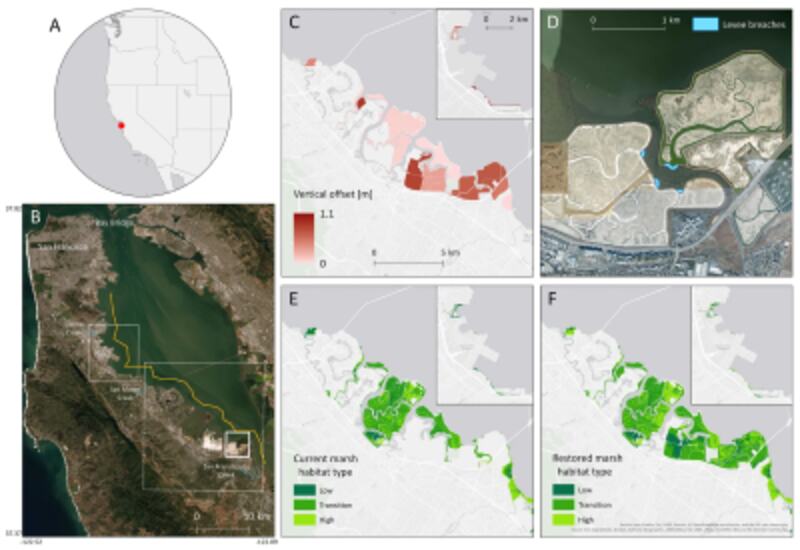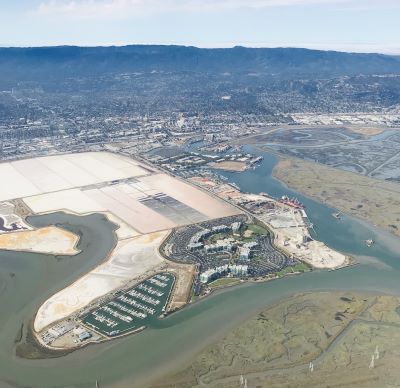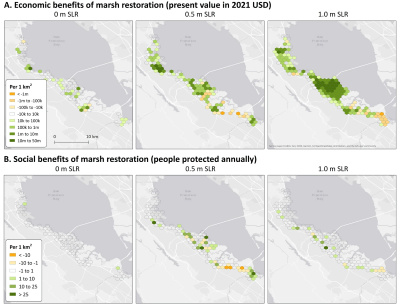Salt marsh restoration study reveals promising results for climate resilience

Supercomputer simulations demonstrate the transformative power of salt marsh restoration in mitigating flood risk and building climate resilience in the San Francisco Bay.
In the face of climate change and the escalating threats of sea level rise and storm-driven flooding, UC Santa Cruz researchers have made a groundbreaking discovery. Through the use of advanced supercomputer simulations, they have uncovered the immense potential of salt marsh restoration as a critical tool in reducing flood risk and bolstering community resilience in our local waterways.
The study delves into the social, economic, and ecological benefits of marsh restoration. The research team, led by a postdoctoral fellow from UC Santa Cruz's Center for Coastal Climate Resilience (CCCR), worked closely with local flood managers and planners to incorporate their expertise into the models.
Using a hydrodynamic model of San Francisco Bay, particularly focusing on San Mateo County, the most vulnerable county to future flooding in California, the team ran supercomputer simulations of the shoreline in both restored and non-restored scenarios during storms. The results were nothing short of remarkable. 
"We have found compelling evidence that marsh restoration can reduce flood risk to people and property locally, providing both community and ecosystem co-benefits," revealed Rae Taylor-Burns, a fellow at CCCR.
"The Bay Area, being low-lying and densely populated, faces significant risk from climate change impacts. By restoring our marshes, we can not only protect ourselves but also stimulate ecological revival."
The study identified priority areas in San Mateo County where salt marsh restoration could maximize socio-economic impacts by reducing flood risk. With the help of a detailed flood model, researchers evaluated the risk of flooding with and without salt marshes and highlighted the areas where restoration interventions would make the most significant difference.
Crucially, the study also placed a monetary value on the flood risk reduction benefits, highlighting the cost-effectiveness of investing in marsh restoration. This opens doors to potential public and private funding opportunities for restoration projects.
However, the implications of wetland restoration go far beyond flood protection alone. The study underlines the multiple benefits that come with it, including carbon sequestration, habitat preservation, and recreational opportunities. It paints a compelling case for embracing nature-based solutions and adopting comprehensive climate resilience strategies that can help mitigate the impacts of future climate change.
"We must explore innovative solutions to enhance community resilience in the face of escalating climate challenges," emphasized Michael W. Beck, director of the Center for Coastal Climate Resilience and a co-author of the study. "Salt marsh restoration represents a nature-based approach that can not only complement traditional infrastructure but also safeguard our coastal communities."
The findings from this study offer hope and inspiration for coastal communities worldwide facing similar threats. By integrating salt marsh restoration into their climate resilience strategies, they can leverage funding opportunities from programs like FEMA grants or initiatives like Regional Measure AA, which provides significant financial support for marsh restoration throughout San Francisco Bay.
We must recognize the critical role of our coastal wetlands as national infrastructure. The Center for Coastal Climate Resilience's work extends beyond California, providing support for coral reefs in regions such as Guam, Hawai'i, Puerto Rico, and the U.S. Virgin Islands. By elevating the importance of coastal wetlands, we can ensure their protection and preservation, not just for ourselves but also for future generations.
As we navigate the challenges of climate change, let us embrace the power of scientific advancements, such as supercomputer simulations, to guide us toward sustainable solutions. By restoring salt marshes, we have a tangible opportunity to safeguard our communities, foster ecological rejuvenation, and forge a resilient future amidst the changing tides.
In the words of Michael W. Beck, "Nature beckons us to adapt and thrive. Let us heed its call and embark on a journey towards a safer and more resilient tomorrow." 


 How to resolve AdBlock issue?
How to resolve AdBlock issue?